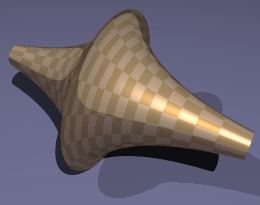 | ||
In geometry, the term pseudosphere is used to describe various surfaces with constant negative Gaussian curvature. Depending on context, it can refer to either a theoretical surface of constant negative curvature, to a tractricoid, or to a hyperboloid.
Contents
Theoretical pseudosphere
In its general interpretation, a pseudosphere of radius R is any surface of curvature −1/R2, by analogy with the sphere of radius R, which is a surface of curvature 1/R2. The term was introduced by Eugenio Beltrami in his 1868 paper on models of hyperbolic geometry.
Tractricoid
The term is also used to refer to a certain surface called the tractricoid: the result of revolving a tractrix about its asymptote. As an example, the (half) pseudosphere (with radius 1) is the surface of revolution of the tractrix parametrized by
It is a singular space (the equator is a singularity), but away from the singularities, it has constant negative Gaussian curvature and therefore is locally isometric to a hyperbolic plane.
The name "pseudosphere" comes about because it is a two-dimensional surface of constant negative curvature just like a sphere with positive Gauss curvature. Just as the sphere has at every point a positively curved geometry of a dome the whole pseudosphere has at every point the negatively curved geometry of a saddle.
As early as 1693 Christiaan Huygens found that the volume and the surface area of the pseudosphere are finite, despite the infinite extent of the shape along the axis of rotation. For a given edge radius R, the area is 4πR2 just as it is for the sphere, while the volume is 2/3πR3 and therefore half that of a sphere of that radius.
Universal covering space
The half pseudosphere of curvature −1 is covered by the portion of the hyperbolic upper half-plane with y ≥ 1. The covering map is periodic in the x direction of period 2π, and takes the horocycles y = c to the meridians of the pseudosphere and the vertical geodesics x = c to the tractrices that generate the pseudosphere. This mapping is a local isometry, and thus exhibits the portion y ≥ 1 of the upper half-plane as the universal covering space of the pseudosphere. The precise mapping is
where
is the parametrization of the tractrix above.
Hyperboloid
In some sources that use the hyperboloid model of the hyperbolic plane, the hyperboloid is referred to as a pseudosphere. This usage of the word is because the hyperboloid can be thought of as a sphere of imaginary radius, embedded in a Minkowski space.
